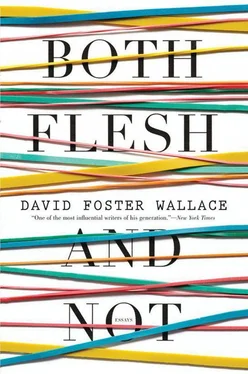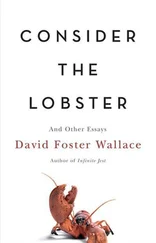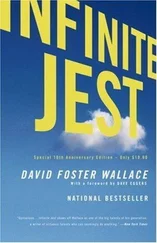THE (AS IT WERE) SEMINAL IMPORTANCE OF TERMINATOR 2
1990s MOVIEGOERS WHO HAVE sat clutching their heads in both awe and disappointment at movies like Twister and Volcano and The Lost World can thank James Cameron’s Terminator 2: Judgment Day for inaugurating what’s become this decade’s special new genre of big-budget film: Special Effects Porn. “Porn” because, if you substitute F/X for intercourse, the parallels between the two genres become so obvious they’re eerie. Just like hard-core cheapies, movies like Terminator 2 and Jurassic Park aren’t really “movies” in the standard sense at all. What they really are is half a dozen or so isolated, spectacular scenes — scenes comprising maybe twenty or thirty minutes of riveting, sensuous payoff — strung together via another sixty to ninety minutes of flat, dead, and often hilariously insipid narrative.
T2, one of the highest-grossing movies in history, opened six years ago. Think of the scenes we all still remember. That incredible chase scene and explosion in the L.A. sluiceway and then the liquid metal 1T-1000 Terminator walking out of the explosion’s flames and morphing seamlessly into his Martin-Milner-as-Possessed-by-Hannibal-Lecter corporeal form. The T-1000 rising hideously up out of that checkerboard floor, the T-1000 melting headfirst through the windshield of that helicopter, the T-1000 freezing in liquid nitrogen and then collapsing fractally apart. These were truly spectacular images, and they represented exponential advances in digital F/X technology. But there were at most maybe eight of these incredible sequences, and they were the movie’s heart and point; the rest of T2 is empty and derivative, pure mimetic polycelluloid.
It’s not that T2 is totally plotless or embarrassing — and it does, admittedly, stand head and shoulders above most of the F/X Porn blockbusters that have followed it. It’s rather that T2 as a dramatic narrative is slick and cliché and calculating and in sum an appalling betrayal of 1984’s The Terminator. T1, which was James Cameron’s first feature film and had a modest budget and was one of the two best U.S. action movies of the entire 1980s, 2was a dark, breathlessly kinetic, near-brilliant piece of metaphysical Ludditism. Recall that it’s A.D. 2027 and that there’s been a nuclear holocaust in 1997 and that chip-driven machines now rule, and “Skynet,” the archonic diabolus ex machina, develops a limited kind of time-travel technology and dispatches the now classically cyborgian A. Schwarzenegger back to 1984’s Los Angeles to find and Terminate one Sarah Connor, the mother-to-be of the future leader of the human “Resistance,” one John Connor 3; and that apparently the Resistance itself somehow gets one-time-only access to Skynet’s time-travel technology and sends back to the same space-time coordinates a Resistance officer, the ever-sweaty but extremely tough and resourceful Kyle Reese, to try desperately to protect Ms. Sarah Connor from the Terminator’s prophylactic advances, 4and so on. It is, yes, true that Cameron’s Skynet is basically Kubrick’s HAL, and that most of T1 ’s time-travel paradoxes are reworkings of some fairly standard Bradbury-era science fiction themes, but The Terminator still has a whole lot to recommend it. There’s the inspired casting of the malevolently cyborgian Schwarzenegger as the malevolently cyborgian Terminator, the role that made Ahnode a superstar and for which he was utterly and totally perfect (e.g., even his goofy 16-r.p.m. Austrian accent added a perfect little robofascist tinge to the Terminator’s dialogue 5). There’s the first of Cameron’s two great action heroines 6in Sarah Connor, as whom the limpid-eyed and lethal-lipped Linda Hamilton also turns in the only great performance of her career. There is the dense, greasy, marvelously machinelike look of The Terminator ’s mechanized F/X 7; there are the noirish lighting and Dexedrine pace that compensate ingeniously for the low budget and manage to establish a mood that is both exhilarating and claustrophobic. 8Plus T1 ’s story had at its center a marvelous “Appointment in Samarra”—like irony of fate: we discover in the course of the film that Kyle Reese is actually John Connor’s father, 9and thus that if Skynet hadn’t built its nebulous time machine and sent back the Terminator, Reese wouldn’t have been back here in ’84, either, to impregnate Sarah C. This also entails that meanwhile, up in A.D. 2027, John Connor has had to send the man he knows is his father on a mission that J.C. knows will result in both that man’s death and his (i.e., J.C.’s) own birth. The whole ironic mess is simultaneously Freudian and Testamental and is just extraordinarily cool for a low-budget action movie.
Its big-budget sequel adds only one ironic paradox to The Terminator ’s mix: in T2, we learn that the “radically advanced chip” 10on which Skynet’s CPU is (will be) based actually came (comes) from the denuded and hydraulically pressed skull of T1 ’s defunct Terminator… meaning that Skynet’s attempts to alter the flow of history bring about not only John Connor’s birth but Skynet’s own, as well. All T2 ’s other important ironies and paradoxes, however, are unfortunately unintentional and generic and kind of sad.
Note, for example, the fact that Terminator 2: Judgment Day, a movie about the disastrous consequences of humans relying too heavily on computer technology, was itself unprecedentedly computer-dependent. George Lucas’s Industrial Light and Magic, subcontracted by Cameron to do T2 ’s special effects, had to quadruple the size of its computer graphics department for the T-1000 sequences, sequences that also required digital-imaging specialists from around the world, thirty-six state-of-the-art Silicon Graphics computers, and terabytes of specially invented software programs for seamless morphing, realistic motion, digital “body socks,” background-plate compatibility, congruences of lighting and grain, etc. And there is no question that all the lab work paid off: in 1991, Terminator 2 ’s special effects were the most spectacular and real-looking anybody had ever seen. They were also the most expensive.
T2 is thus also the first and best instance of a paradoxical law that appears to hold true for the entire F/X Porn genre. It is called the Inverse Cost and Quality Law, and it states very simply that the larger a movie's budget is, the shittier that movie is going to be. The case of T2 shows that much of the ICQL’s force derives from simple financial logic. A film that would cost hundreds of millions of dollars to make is going to get financial backing if and only if its investors can be maximally— maximally —sure that at the very least they will get their hundreds of millions of dollars back. 11I.e., a megabudget movie must not fail — and “failure” here means anything less than a runaway box-office hit — and must thus adhere to certain reliable formulae that have been shown by precedent to maximally ensure a runaway hit. One of the most reliable of these formulae involves casting a superstar who is “bankable” (i.e., whose recent track record of films shows a high ROI). The studio backing for T2 ’s wildly sophisticated and expensive digital F/X therefore depends on Mr. Arnold Schwarzenegger agreeing to reprise his Terminator role. Now the ironies start to stack, though, because it turns out that Schwarzenegger — or perhaps more accurately “Schwarzenegger, Inc.” or “Ahnodyne”—has decided that playing any more malevolent cyborgs would compromise the Leading Man image his elite and bankable record of ROI entails. He will do the film only if T2 ’s script is somehow engineered to make the Terminator the Good Guy. Not only is this vain and stupid and shockingly ungrateful 12; it is also common popular knowledge, duly reported in both the trades and the popular entertainment media before T2 even goes into production. There’s consequently a weird postmodern tension to the way we watch the film: we’re aware of what the bankable star’s demands were, and we’re also aware of how much the movie cost and how important bankable stars are to a big-budget movie; and so one of the few things that keep us on the edge of our seats during the movie is our suspense about whether James Cameron can possibly weave a plausible, non-cheesy narrative that meets Schwarzenegger’s career needs without betraying T1 ’s precedent.
Читать дальше












